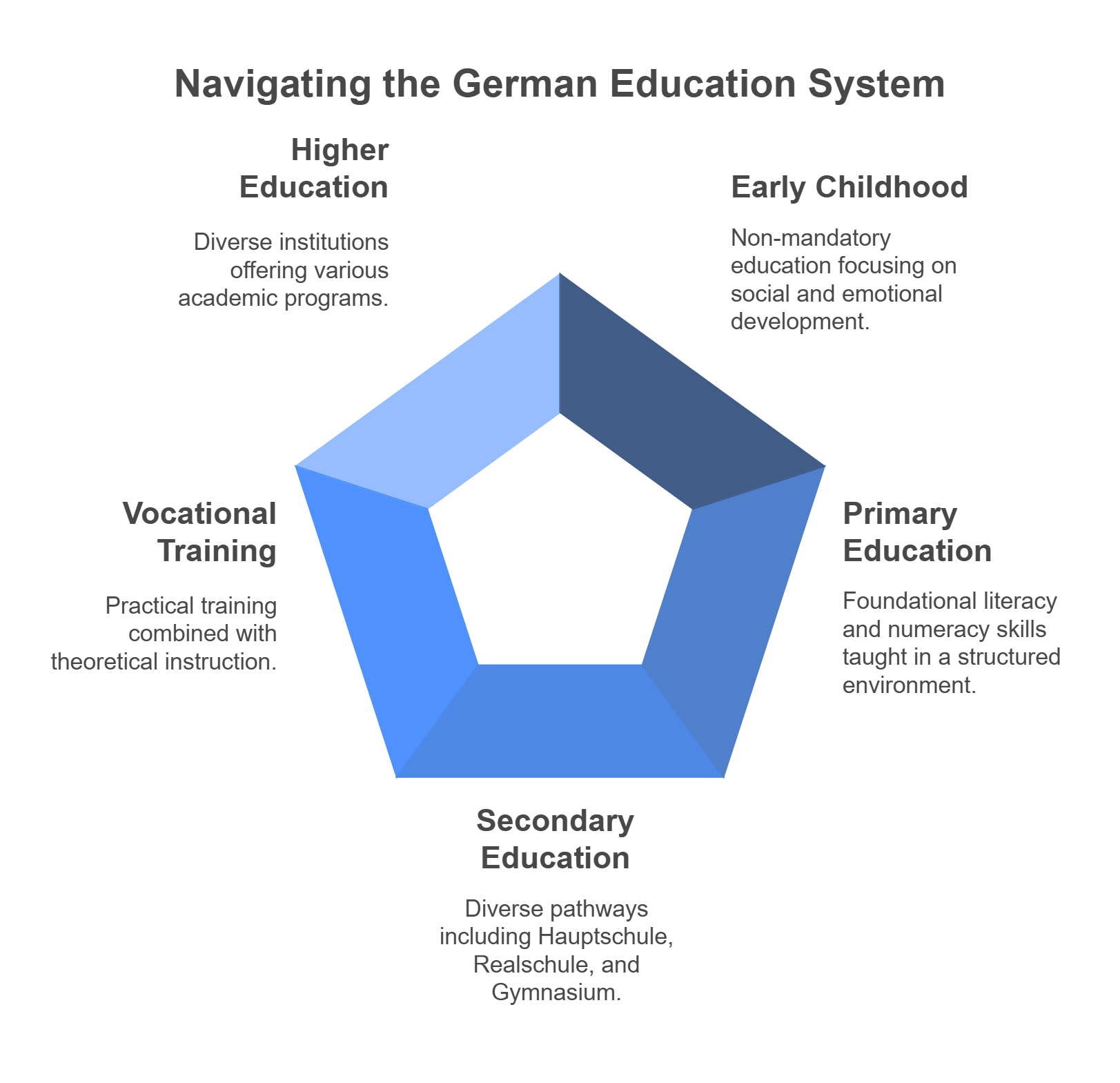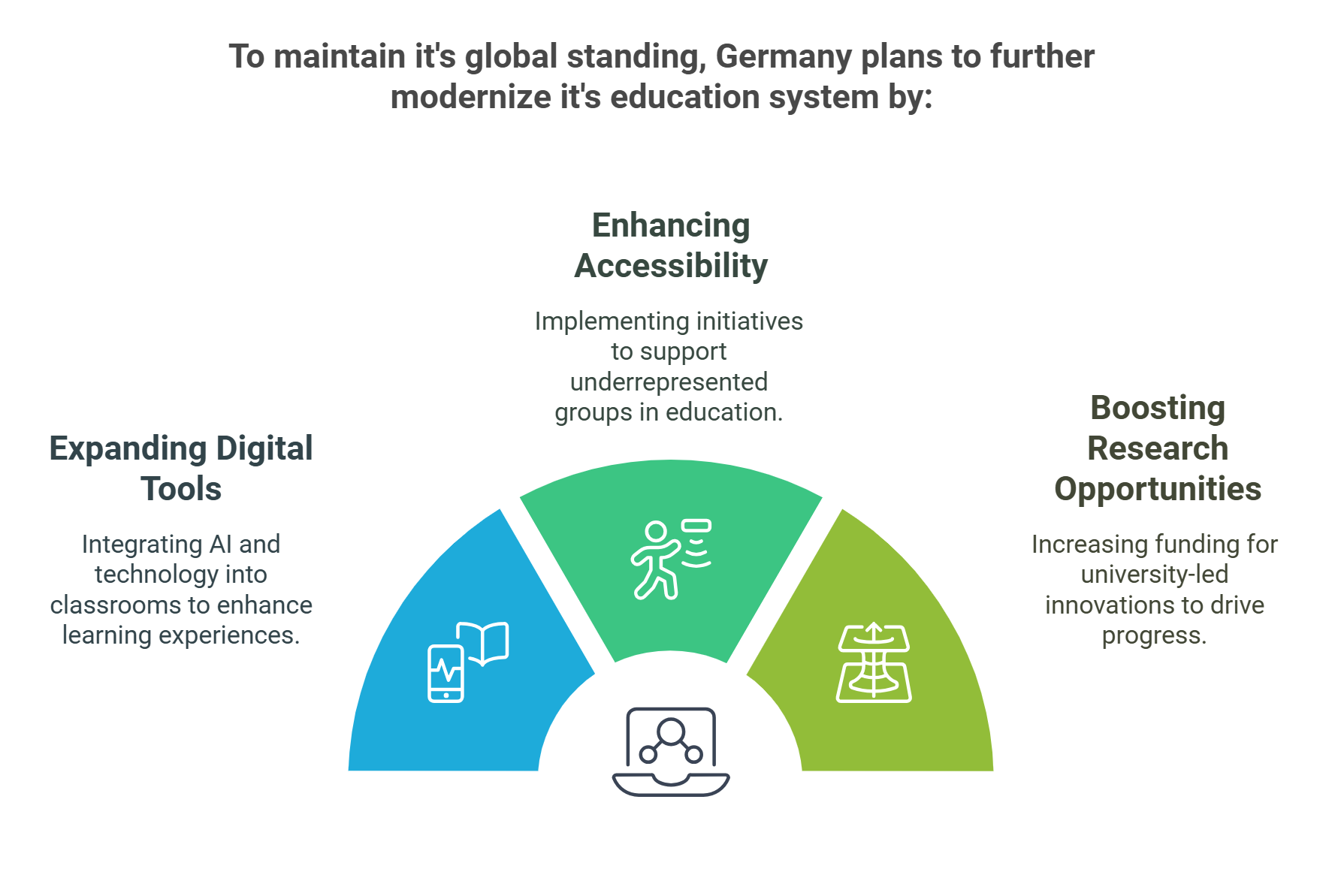.png?h=35&w=35&mode=stretch)
Yatin Kumar Study Abroad Content Specialist
Study Abroad Content Specialist
Germany’s education system stands out globally for its structured approach and efficient integration of academic and vocational training. With over 50% of secondary students participating in the renowned dual education system, Germany ensures a seamless transition from education to employment. The country’s decentralized framework allows each of the 16 federal states to tailor educational policies while adhering to nationwide standards, creating a balanced yet flexible system.
At the core of this system lies a commitment to accessibility and quality. Public universities, which are predominantly tuition-free, attract international students from over 180 countries. Germany’s robust vocational education and training (VET) program boasts a 90% post-graduation employment rate, showcasing its alignment with industry demands.
- Governance of the Education System in Germany
- Compulsory Education in Germany
-
-
- Vocational Education and Training (VET)
- Higher Education Landscape in Germany
- Challenges and Modernization Efforts
-
-
Governance of the Education System in Germany
Education in Germany operates under the framework of the Basic Law (Grundgesetz). While the Federal Ministry of Education and Research (BMBF) coordinates and supports education at the national level, responsibility primarily lies with the 16 federal states (Bundesländer). Each state has its own Ministry of Education, determining policies such as curriculums, teacher qualifications, and school organization.
This decentralized approach results in some regional differences in educational practices but ensures adaptability to local needs.
Compulsory Education in Germany
- Age Range: From 6 years to 15/16 years.
- Requirements:
- 9 years of full-time schooling (Gymnasium).
- 10 years of full-time schooling in other general education schools.
- Berufsschule Obligation: After general compulsory schooling, part-time vocational schooling is mandatory until age 18 for students not pursuing higher education.
- Special Education Needs: Children with disabilities are integrated into regular schools or attend specialized institutions based on individual needs.
Key Stages of Education in Germany
The German education system comprises five main stages:
| Stage | Age Group | Duration | Key Features |
|---|---|---|---|
| Early Childhood Education | 0–6 years | Variable | Non-mandatory, emphasizes social and emotional development through Kindergartens. |
| Primary Education | 6–10 years | 4 years | Focus on foundational literacy, numeracy, and interdisciplinary learning. |
| Secondary Education | 10–18 years | 4–8 years | Split into Hauptschule, Realschule, Gymnasium, or Gesamtschule. |
| Vocational Training (VET) | 16–19 years | 2–3 years | Dual system blending theoretical instruction with paid apprenticeships. |
| Higher Education | 18+ years | Variable | Includes universities, applied sciences, and art institutions; often tuition-free. |

Secondary Education: A Tiered System
Secondary education channels students into pathways based on performance, teacher recommendations, and parental preferences:
| School Type | Grades | Focus | Outcomes |
|---|---|---|---|
| Hauptschule | 5–9/10 | Basic education, vocational training | Prepares for apprenticeships and low-skilled jobs. |
| Realschule | 5–10 | Intermediate academic and practical | Leads to vocational training or higher education. |
| Gymnasium | 5–12/13 | Rigorous academic curriculum | Prepares for university via the Abitur. |
| Gesamtschule | 5–12/13 | Comprehensive and flexible | Allows transitions between academic and vocational tracks. |
Vocational Education and Training (VET)
Germany’s dual system is globally recognized for bridging education and employment:
| Metric | Details |
|---|---|
| Participation Rate | ≈50% of post-secondary students. |
| Industries Covered | Manufacturing, healthcare, IT, engineering. |
| Average Training Stipend | €800–1,200/month. |
| Post-VET Employment Rate | Over 90%. |
Higher Education Landscape in Germany
Germany’s higher education system attracts students worldwide with its tuition-free public universities and diverse programs.
| Institution Type | Focus | Examples of Programs |
|---|---|---|
| Universities | Research and theory | Medicine, Engineering, Humanities. |
| Universities of Applied Sciences | Practical and industry-linked | Business, Design, IT. |
| Colleges of Art, Film, and Music | Creative disciplines | Fine Arts, Filmmaking, Music. |

Challenges and Modernization Efforts
Listed are some of the challenges and modernization efforts people face:
| Challenge | Description |
|---|---|
| Integration of Migrants | Addressing language barriers and cultural diversity. |
| Educational Inequality | Bridging socio-economic disparities in access to quality education. |
| Teacher Shortages | Recruiting qualified educators, particularly in STEM fields. |
| Digitalization Gaps | Enhancing infrastructure and online learning tools post-pandemic. |
Reforms and Policies in Germany
Germany is tackling these challenges through targeted reforms:
- Digitalization Investments: €5 billion for technology upgrades in schools.
- Teacher Training Programs: Financial incentives to attract new educators.
- Inclusive Education Policies: Extra funding for integrating migrant and special needs students.
- Flexible Pathways: Expansion of Gesamtschulen to support diverse learning needs.
Global Appeal for International Students
Germany’s education system offers numerous advantages for international students:
| Factor | Details |
|---|---|
| Cost-Effective Education | Tuition-free programs for most courses. |
| Quality of Institutions | Home to 10+ universities in global top 100. |
| Post-Graduation Opportunities | Favorable visa policies and strong job market. |

Germany’s education system exemplifies a harmonious balance between academic excellence and vocational readiness. Through its reforms and inclusivity measures, it continues to uphold global standards and remain an attractive destination for learners worldwide. By addressing persistent challenges, Germany is poised to further solidify its role as a leader in education and innovation.





1720688571.png?tr=w-305,h-145,c-force?h=40&w=40&mode=stretch)















Comments